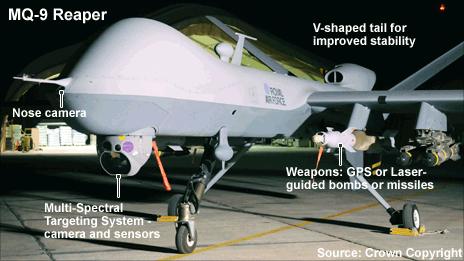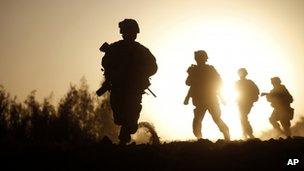Viewpoint: Drones, modern war, and the US
- Published

Relatives of an American-born suspected al-Qaeda militant are suing US officials over his death in a drone strike. Is the long-running US drone programme legal - and are Americans legitimate targets?
On 3 November 2002, the United States carried out its first known targeted killing.
Over the desert near Sanaa, Yemen, an armed drone controlled by the Central Intelligence Agency (CIA) targeted and killed Qaed Salim al-Harethi, a senior al-Qaeda lieutenant. His killing had been authorised by former President George W Bush.
This was not the first use of an armed drone. In World War II the Nazis targeted England with several thousand V1 "buzz bombs" and V2 rockets.
The Israelis practiced "focused foiling" throughout the late 20th Century, although most Israeli missile strikes were launched from manned helicopters. The US consistently criticised the Israeli practice as extrajudicial murder.
After 9/11, however, America found targeted killing an effective tactic, and <link> <caption>drones an efficient means</caption> <url href="http://www.bbc.co.uk/news/world-south-asia-10713898" platform="highweb"/> </link> of carrying it out.
Collateral damage
In the law of armed conflict drones and their missiles are lawful weapons, essentially no different than artillery, an historic weapon of war.
Artillery employs spotters relaying information about targets - say, an enemy commander - to a site where large-calibre guns are aimed and fired at the distant target.
Drones are the spotters that relay information about targets to command centres where targeting cells confirm the lawfulness of the target and, like firing an artillery piece, trigger the drone's missiles.
In an important respect, armed drones are superior weapons to traditional artillery. Rather than firing multiple artillery rounds, often a score or more, drones fire one or two missiles. Artillery, with its dispersion pattern at point of impact, requires multiple rounds to assure a target hit. A missile is guided to its target with exacting precision.
The potential for collateral damage - the unintentional killing of civilians - is greatly minimised by drone strikes.
Ironically, a missile's very precision raises objection to drones in the civilian community: "Innocent civilians are killed by missile-firing drones!"

The US has not officially taken responsibility for the drone strike that killed Anwar al-Awlaki
That objection is seldom voiced regarding artillery barrages, which are greatly more likely to kill many more civilians than a Hellfire missile.
Provisions <link> <caption>within the Geneva Convention</caption> <url href="http://www.icrc.org/eng/war-and-law/treaties-customary-law/geneva-conventions/index.jsp" platform="highweb"/> </link> specifically do not bar military strikes when civilians are present. The rules are usually applied to preclude human shields, but are also applicable to artillery and missile strikes.
Proportionality - the balancing of possible civilian death or injury against the immediate military advantage to be gained - is always an issue commanders must consider before authorising a strike.
But the presence of civilians in a target zone is not in itself a prohibiting factor.
Recognising the enemy
Nevertheless, any lawful weapon can be employed in an unlawful manner.
Targeted killing presumes a specific individual target in the course of an armed conflict: someone who by his or her actions, or position in an opposing armed force or organisation, is a confirmed enemy fighter.
Such individuals may be placed on a military target list and lawfully be killed when located and identified.
If the intelligence confirming their status as an enemy fighter is defective, or insufficient to positively identify that person, any subsequent strike would violate US rules of engagement as well as the law of armed conflict.
Recently authorised "signature" missile strikes pose an increased possibility of targeting error. A signature strike is based on the target's intelligence "signature" - his pattern of behaviour detected through signals intercepts, human sources and aerial surveillance - indicating an important enemy individual involved in a plot against American interests.
Assessing involvement in a plot contrary to American interests can cover a broad range of behaviour and be open to interpretation.
No passport necessary
Can American citizens lawfully be targeted by drone-fired missiles? Yes.
Individual human targeting is based upon the target's conduct: Is she aiming a weapon at you? Does he clearly represent a threat to you or your fellow soldiers?
If so, that person may be killed by an opposing combatant. Citizenship plays no role in targeting decisions.
In World War II, numerous US citizens of German, Japanese, or Italian ancestry returned to countries of their heritage and fought for those states. There was no suggestion that it was illegal for US troops to kill them when they met.

In fighting al-Qaeda, the US has had to move away from traditional intelligence and tactics
When an enemy fighter is about to fire on you, you need not ask to see his passport before killing him.
When the targeting is via a drone, however, one must ensure that the target, American or otherwise, is indeed an enemy fighter.
Anwar al-Awlaki, <link> <caption>the US-born Muslim cleric</caption> <url href="http://www.bbc.co.uk/news/world-middle-east-15124351" platform="highweb"/> </link> , was killed by a CIA-controlled two-drone missile strike in September 2011.
Awlaki was described as an al-Qaeda operational leader, although the evidence supporting that assertion has not been released.
Military targeting parameters are widely known, although there is no requirement in law or custom that they be made public. CIA targeting standards, however, remain secret.
In the Awlaki case, that secrecy disturbs many who want assurance that he was not killed simply because he talked too much, too loudly, too long - which would be a war crime.
In summary, drones and their missiles are lawful weapons, little different from artillery, naval gunfire, or close air support by manned aircraft.
Because of the nature of the war on terrorism, in which the enemy does not identify himself in traditional ways, identifying lawful drone targets is difficult. It nevertheless is done with skill and professionalism by American and allied warfighters.
Yet mistakes are made. Civilians are killed. To say that is the nature of war, and always has been, is not cynicism so much as a recognition of sad reality.
- Published31 January 2012
- Published6 June 2012
- Published5 June 2012